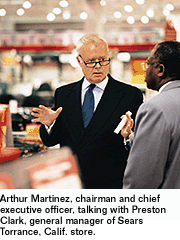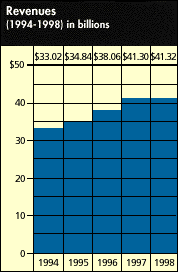 |
 The year 1998 produced a number of measurable successes, but
on balance was challenging. Most importantly, we achieved dramatically
improved results in our credit segment. Within our retail segment, we
continued our leadership in hardgoods in our full-line and specialty
stores, achieving solid sales and market share gains. These gains were
offset, however, by a slowdown in our apparel business. We continued to
invest in our services segment, which we consider to be an extraordinary
opportunity for Sears even though we did not reach our aggressive growth
targets for 1998. We made substantial progress in streamlining our
business portfolio, with transactions involving our HomeLife furniture and
Western Auto/Parts America businesses. We also continued to manage
expenses well, with selling and administrative expenses as a percentage of
total revenues reduced year over year. The year 1998 produced a number of measurable successes, but
on balance was challenging. Most importantly, we achieved dramatically
improved results in our credit segment. Within our retail segment, we
continued our leadership in hardgoods in our full-line and specialty
stores, achieving solid sales and market share gains. These gains were
offset, however, by a slowdown in our apparel business. We continued to
invest in our services segment, which we consider to be an extraordinary
opportunity for Sears even though we did not reach our aggressive growth
targets for 1998. We made substantial progress in streamlining our
business portfolio, with transactions involving our HomeLife furniture and
Western Auto/Parts America businesses. We also continued to manage
expenses well, with selling and administrative expenses as a percentage of
total revenues reduced year over year.
Because strong credit and international results helped offset a decline in retail results, earnings per share, excluding noncomparable items, were $3.32 in 1998 versus $3.27 in the prior year. Credit business rebounds after difficult year We began to benefit from these efforts in the second half of 1998 and saw a decline in delinquencies, bankruptcies and charge-offs. As we look ahead in 1999, a number of new initiatives in our credit business will be implemented, including the transition to a state-of-the-art customer account management system. To be completed in mid-1999, our new credit system allows us to enhance our relationship with our credit customers. We also reached final resolution of a major credit compliance issue. Since learning in early 1997 that our credit reaffirmation practices with bankrupt customers were deficient, we corrected our practices, repaid the affected customers and settled related lawsuits. In February 1999, we reached agreement with the U.S. Attorney to settle related complaints, which included accepting a fine of $60 million. Although the fine will have no impact on 1999 results because of the charge taken against earnings in 1997, it is a particularly graphic reminder to us all of the importance of operating with integrity at all times. Retail segment led by strength in hardgoods Our strong execution in these businesses provides an excellent model for our other retail businesses: offer a strong assortment of national brands, complemented with outstanding proprietary private brands such as Kenmore and Craftsman; provide multiple ways for customers to shop with us - full-line stores, specialty stores, catalogs, direct mail and the Internet; add a high level of customer service before, during, and after the sale, supported by excellent credit offerings; do this at a very competitive price; and, importantly, tell the customer about it in a clear and compelling way. The customer responds to this value proposition, and it is the heart of our game plan for 1999 across our retail, services and credit businesses. Renewed focus on apparel offerings For example, in addition to collections from First Issue, a Liz Claiborne company, we will begin carrying a line of Benetton sportswear in 1999. Both are Sears exclusives. We also have strengthened our private brands, further expanding Crossroads for women, Fieldmaster and CRB Khakis for men and TKS Basics for children. These have the potential to become the "Kenmore" and "Craftsman" brands of our apparel business - offering the quality and style customers want at unbeatable prices for the value provided. We also are in the process of refocusing our marketing approach to better highlight our strong value proposition. We will build upon the five-year, $4 billion store remodeling program we began in 1993. Last year we substantially completed our program, raising the balance of softgoods selling space in our 845 full-line stores and transforming them into more exciting, contemporary places to shop. Our new focus will be on creating more in-store shops to display brands in a relevant, customer-friendly way. |
Annual Report Contents | Previous | Next | |
 Despite the fact that
several apparel categories did well - including women's special sizes,
fine jewelry, cosmetics and fragrances - our softgoods sales lagged in
1998 after five years of consistent, substantial growth. We are working
diligently to correct the situation. This will require editing our fashion
assortments and reducing the number of suppliers and items offered, as
well as strengthening our portfolio of national and private brands.
Improving the clarity and competitiveness of our apparel offering is
central to success in this hotly competitive arena.
Despite the fact that
several apparel categories did well - including women's special sizes,
fine jewelry, cosmetics and fragrances - our softgoods sales lagged in
1998 after five years of consistent, substantial growth. We are working
diligently to correct the situation. This will require editing our fashion
assortments and reducing the number of suppliers and items offered, as
well as strengthening our portfolio of national and private brands.
Improving the clarity and competitiveness of our apparel offering is
central to success in this hotly competitive arena.